In the game of Stardew Valley, there is a list of skills/activities that players can partake in. This list includes farming, foraging, fishing, mining, and combat. The next few main posts I create will go over these skills and talk about what the skill is, how to level up the skill, tips and tricks, items that are connected to the skill, different professions to choose from, and any other crucial information. For this week I will be covering the topic of farming and foraging!
Farming in the Valley
One of the most popular skills/activities available in the game is farming! In this section of the post, I will discuss different buildings on your farmland, tasks/activities that fall in the farming category, and tools to use for this skill, and the professions available.
Buildings
Within the game, there are multiple different types of farms to choose from when first starting the game. Check out my Getting Started Post to see the list of farmlands and their pros and cons! Even though there are different types of farms, there are building or other attributes that are included in all the farm types.
Your Farmhouse
One of the first buildings you will notice is your farmhouse. When first starting the game it looks like it’s in rough shape, but no need to worry, you can make house upgrades with the carpenter, Robin. However, your farmhouse is exactly what it sounds like. It is where you go to sleep each night, store items, and you can even decorate it however you would like.
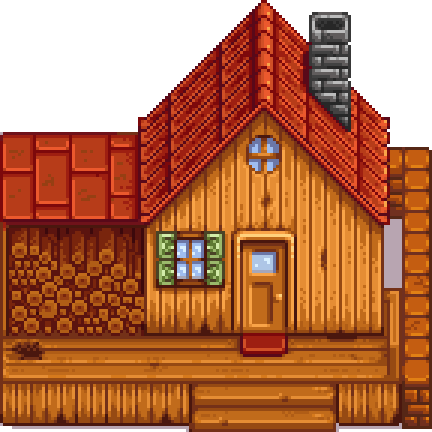
The Greenhouse
On your farmland you may notice a broken building, this is or was a greenhouse. To be able to rebuild the greenhouse you must complete some bundles in the Community Center. You have to complete all of the bundles that are in the Pantry (in a later post I will be talking more about Community Center bundles). Once you finish the bundles, the next day your greenhouse will be good as new. The greenhouse is a nice addition to the farm because then you are able to grow crops in the winter!

The Cave
While walking around your farm you may also notice a cave entrance at the north part of your farm. When you enter at first it is just an empty cave. However, when you obtain 25,000 gold Demetrius, a scientist of the valley, will come to you and say that he would like to use the cave to research specimens. He will give you the option to choose the specimens. One option is fruit bats, which will leave fruit for you in the cave. The second option is mushrooms. The cave is a great way to get extra items for gold or for completing bundles.

Farming Activities
There are many different tasks that you can perform to not only make gold in the game but also raise your farming level. Tasks that fall under the farming category are growing crops and fruit trees and caring for animals.
Growing Crops
In the game, there is a wide selection of different types of crops and trees that you can grow. Every season has a different selection of crops that you can choose from. There are also some crops that you can grow in multiple seasons. Below I will list some of the crops you can grow in each season.
Spring
- Blue Jazz
- Cauliflower
- Garlic
- Green Beans
- Kale
- Parsnip
- Potato
- Rhubarb
- Strawberry
- Tulip
- Rice
Summer
- Blueberry
- Corn
- Hops
- Hot Peppers
- Melon
- Poppy
- Radish
- Red Cabbage
- Starfruit
- Summer Spangle
- Sunflower
- Tomato
- Wheat
Fall
- Amaranth
- Artichoke
- Beet
- Bok Choy
- Cranberries
- Eggplant
- Fairy Rose
- Grapes
- Pumkin
- Yam
As you may have guessed, there are no crops for the winter because you cannot grow crops outside. However, with the greenhouse, you can grow any type of crop in the winter. It is also important to note that there are 28 days in a season. This means when you reach day 28 of a season that will be the last day for your crops to grow. Once that last day ends, the next day all your past season crops will be dead and you must start with the new season’s crops.
You may notice different color stars next to crops when they are picked. These stars tell you the crop quality. When picking crops you can either get regular, silver, gold, or iridium quality. The higher the quality (iridium being the highest) the more crops are worth. You will also see these star qualities on other items from different skills. Below I will post a link so you can find out how much each crop is worse and how long they take to grow.
Growing Fruit Trees
Fruit trees can be planted any season and on the untilled ground. They will also not die in the winter! It is important to know that you must plant your trees in a clear 3×3 ground area otherwise they will not grow. Saplings take about 28 days to mature and start producing one fruit a day. Some examples of trees available are apple, orange, peach, apricot, and cherry trees. A full list of trees and the seasons they grow fruit can be found below.
Caring for Farm Animals
There is a wide range of farm animals that are available in the game like chickens, cows, sheep, goats, ducks, and even ostriches. Chickens and ducks live in coops on your farm while the other animals can be found in your barn(s). Each and every day you must make sure to feed your animals. Hay or fresh grass is the type of food that all the animals eat. Just like in real life, your farm animals give you items like eggs, milk, wool, and feathers.
Tools for Farming
When first starting off on your farm, you will have to basic tools for farming, a hoe and a watering can. These tools are great to get starting with your farm; however, there is another tool that I think makes farming a much easier task. Sprinklers are a great addition to your farm because every morning they water your crops for you. There are three types of sprinklers: regular sprinkler, quality sprinkler, and iridium sprinkler. Each sprinkler has different ranges of how much they can water.
Farming Professions
Below is a picture of the different choices of farming professions at levels 5 and 10.
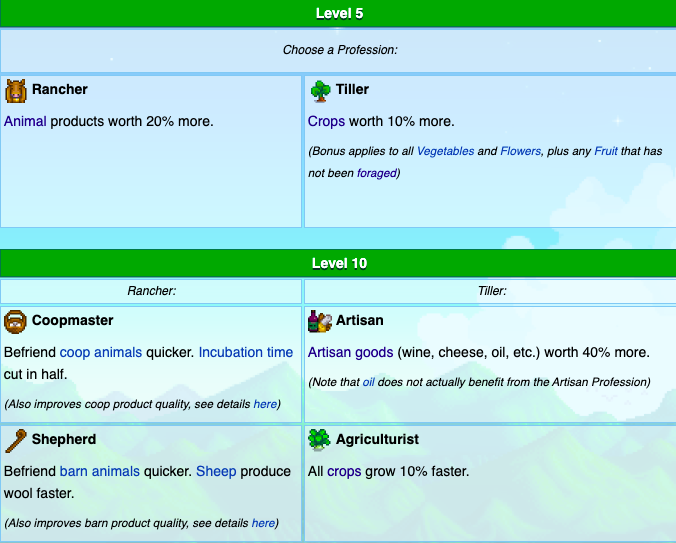
Foraging in the Valley
Foraging in the game is the skill of gathering wild resources found throughout Stardew Valley. Just like in farming, there are certain foraged items available in certain seasons
Spring
- Wild Horseradish
- Daffodil
- Leek
- Dandelion
- Spring Onion
- Morel
- Common Mushroom
- Salmonberry
Summer
- Spice Berry
- Grape
- Sweet Pea
- Red Mushroom
- Fiddlehead Fern
- Common Mushroom
Fall
- Wild Plum
- Hazelnut
- Blackberry
- Chanterelle
- Common Mushroom
- Red Mushroom
- Purple Mushroom
Winter
- Winter Root
- Crystal Fruit
- Snow Yam
- Crocus
- Holly
There are also forage items that can be found at specific places all year round. Below is a link to view the rest of the items.
Foraging Professions
Below is a picture of the different choices of forging professions at levels 5 and 10
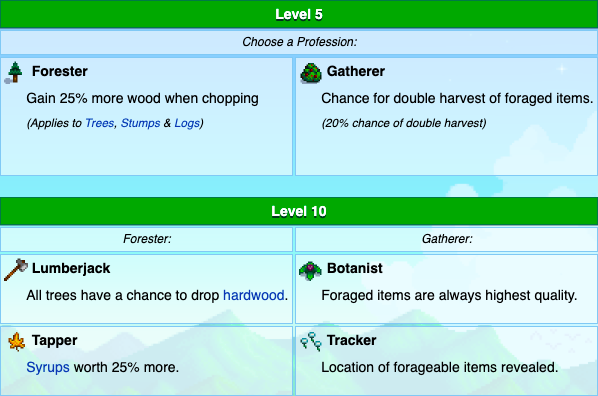
I know that there is a lot of information packed into this post, especially about farming, so don’t be afraid and reach out with any questions you have about these two skills!
All images come from https://stardewvalleywiki.com/Stardew_Valley_Wiki
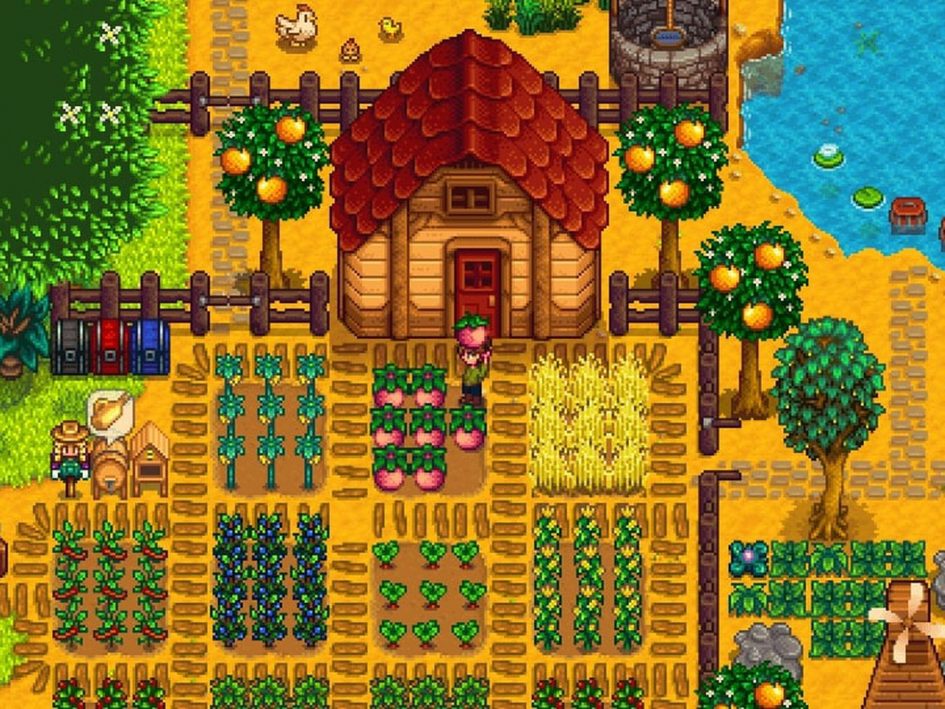
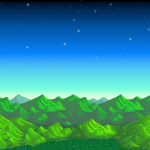
March 22, 2021 at 10:13 pm
This week’s post is very helpful and neatly put together. It easily explains confusing aspects of the game that might be overwhelming to newcomers. Also, the more information buttons are a great addition to the blog.